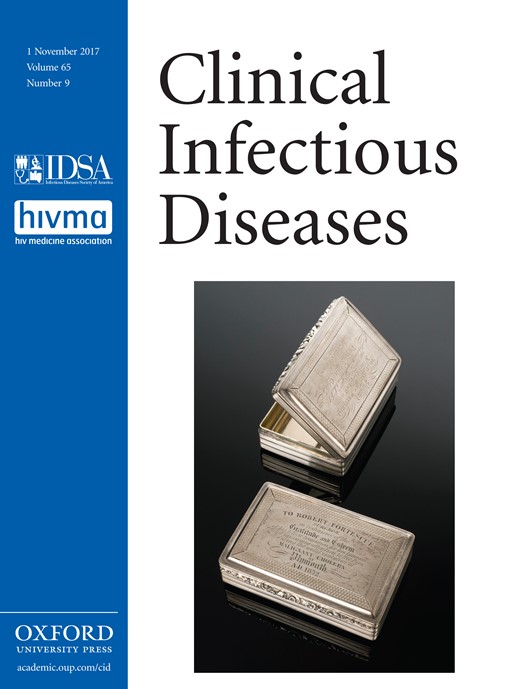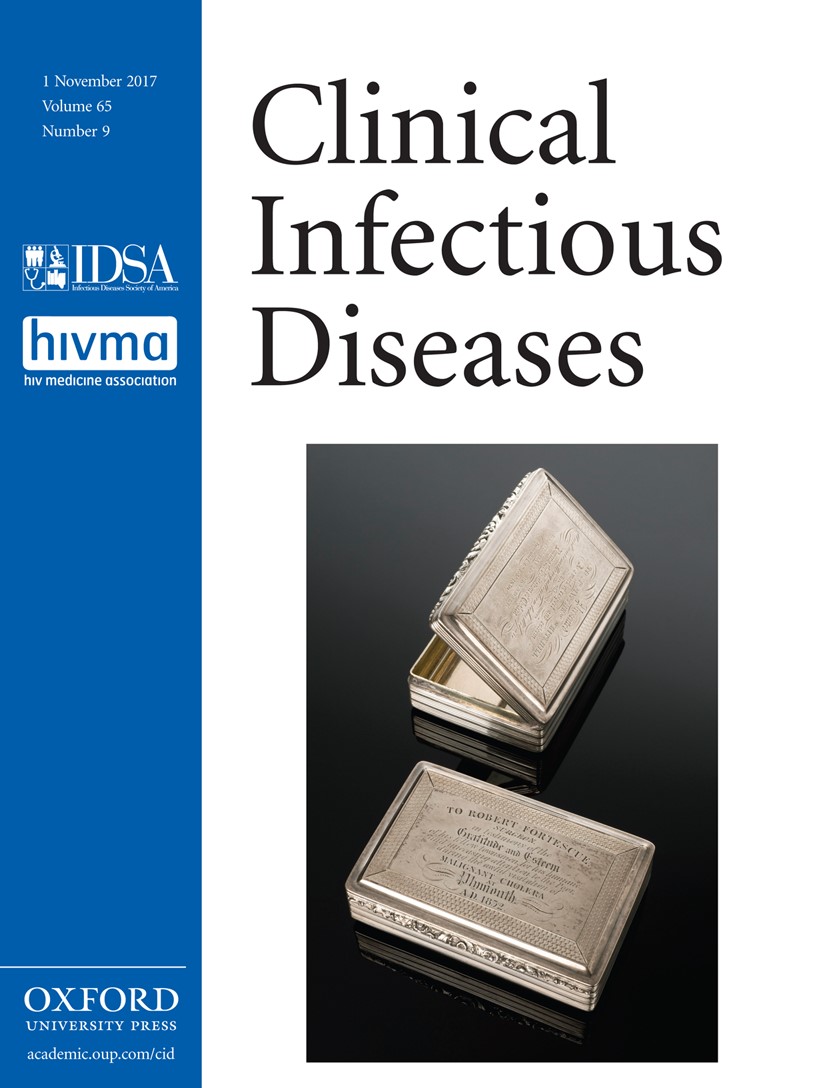
Cover image

Volume 65, Issue 9, 1 November 2017
NEWS
News
IN THE LITERATURE
In the Literature
ARTICLES AND COMMENTARIES
Epidemiology of Pediatric Multidrug-Resistant Tuberculosis in the United States, 1993–2014
Between 1993 and 2014, only 25% of pediatric tuberculosis (TB) cases in the United States had culture-confirmed TB. Among those with culture-based drug susceptibility test results, 82 (1.7%) had multidrug-resistant TB. Most completed treatment (88%) despite extensive first- and second-line drug resistance.
Excellent Treatment Outcomes in Children Treated for Tuberculosis Under Routine Operational Conditions in Cape Town, South Africa
HIV infection increases the risk of developing tuberculosis (TB), but our understanding of HIV’s impact on risk of mortality for children treated for TB is limited. We aimed to identify predictors of mortality in children treated for drug-susceptible TB.
Endothelial Nitric Oxide Pathways in the Pathophysiology of Dengue: A Prospective Observational Study
Endothelial dysfunction/reduced nitric oxide bioavailability is associated with worse plasma leakage in dengue patients and occurs early in the course of the disease. Endothelial dysfunction correlates with lower plasma l-arginine and higher arginase-1 levels.
Guillain-Barré Syndrome Associated With Zika Virus Infection in Martinique in 2016: A Prospective Study
We recorded prospective data from 23 patients with Guillain-Barré syndrome (GBS) with proof of recent Zika virus infection. These new patients were old in age and had severe GBS. Arbovirus RNA detection is useful for GBS cases management.
Impact of Implementing National Guidelines on Antibiotic Prescriptions for Acute Respiratory Tract Infections in Pediatric Emergency Departments: An Interrupted Time Series Analysis
Local implementation of national guidelines in pediatric emergency departments can substantially modify antibiotic prescribing habits, reducing both the antibiotic prescription rate for acute respiratory tract infection and broad-spectrum antibiotic use.
Viral Surveillance in Serum Samples From Patients With Acute Liver Failure By Metagenomic Next-Generation Sequencing
Viral metagenomic surveillance of 187 patients with indeterminate acute liver failure (ALF) from 1998 to 2010 suggests that these patients should be screened for the presence of uncommon viruses and coinfections, although novel viruses associated with ALF were not identified.
Viruses Associated With Unexplained Acute Liver Failure: Next Generation Reveals the Last Generation
Characteristics and Clinical Outcome of Lyme Neuroborreliosis in a High Endemic Area, 1995–2014: A Retrospective Cohort Study in Denmark
Among 431 patients over a 20-year period, with unchanged long treatment delay of 24 days throughout the study period, 15% of patients had negative serum Borrelia antibodies and 28% suffered from residual symptoms after treatment.
Characterizing Human Immunodeficiency Virus Antiretroviral Therapy Interruption and Resulting Disease Progression Using Population-Level Data in British Columbia, 1996–2015
Age, historical plasma viral load, and prior ART regimen changes were independently associated with increased hazard of CD4 decline and death while off ART. ART reengagement interventions need further development and may consider prioritizing individuals with these poorer prognostic factors.
Donor-Derived Mycoplasma hominis and an Apparent Cluster of M. hominis Cases in Solid Organ Transplant Recipients
Mycoplasma spp may be a significantly underappreciated cause of donor-derived infection, and are difficult to detect via routine laboratory methods. Diagnosis of infection by Mycoplasma spp is important as routine posttransplant antibiotics, typically β-lactams, are not effective against species of this genus.
Use of a Dual-Antigen Rapid Diagnostic Test to Screen Children for Severe Plasmodium falciparum Malaria in a High-Transmission, Resource-Limited Setting
This prospective study examined the accuracy of a rapid diagnostic test (RDT) to distinguish severe from uncomplicated malaria. We found that a histidine-rich protein-2+/pan-lactate dehydrogenase+ RDT result has high sensitivity (97.6%) for the detection of severe malaria and significantly outperformed existing algorithms.
Plasmodium malariae in Israeli Travelers: A Nationwide Study
Routine diagnostic measures are unreliable for diagnosis of Plasmodium malariae; thus, polymerase chain reaction utilization should be considered on admission. Furthermore, prophylaxis appears to have a delaying effect on P. malariae symptoms, similar to its effect on the relapsing species.
Immune Cross-Opsonization Withinemm Clusters Following Group AStreptococcus Skin Infection: Broadening the Scope of Type-Specific Immunity
A single skin infection in group AStreptococcus–endemic settings induced a significant immune response in 38% of children. Cross-reactive immune responses occurred after skin infections. These cross-reactive responses frequently aligned withemm clusters.
Burden of Influenza in 4 Ecologically Distinct Regions of Peru: Household Active Surveillance of a Community Cohort, 2009–2015
This study describes population-based estimates for quantifying influenza disease burden, health utilization patterns among participants of all ages, and seasonality in different climactic regions. Findings will help place global influenza burden of disease models into better context by providing case-based incidence.
Risk of Acute Liver Injury After Statin Initiation by Human Immunodeficiency Virus and Chronic Hepatitis C Virus Infection Status
Statin initiators have a lower risk of acute liver injury events and death compared to statin nonusers, regardless of HIV and/or chronic hepatitis C virus infection status.
Plasma But Not Cerebrospinal Fluid Interleukin 7 and Interleukin 5 Levels Pre–Antiretroviral Therapy Commencement Predict Cryptococcosis-Associated Immune Reconstitution Inflammatory Syndrome
High plasma IL-5 and IL-7 levels pre–antiretroviral therapy commencement predict cryptococcosis-associated immune reconstitution inflammatory syndrome (C-IRIS) in a case-control study of cryptocococcal meningitis. These data highlight the role of systemic IL-5/IL-7–related immune dysfunction in the pathogenesis of C-IRIS.
VIEWPOINTS
Outpatient Management of Children With World Health Organization Chest Indrawing Pneumonia: Implementation Risks and Proposed Solutions
World Health Organization Integrated Management of Child Illness guidelines should consider the following revisions for children with chest indrawing pneumonia: referral or daily monitoring with signs of severe respiratory distress, oxygen saturation <93%, moderate malnutrition, or unknown HIV status (when HIV endemic).
Sepsis National Hospital Inpatient Quality Measure (SEP-1): Multistakeholder Work Group Recommendations for Appropriate Antibiotics for the Treatment of Sepsis
Multiple antibiotics listed use in the Severe Sepsis/Septic Shock (SEP-1) Management Bundle in the Center for Medicare and Medicaid Services’ Hospital Inpatient Quality Reporting Program are not appropriate. We provide recommendations for appropriate antibiotics to be utilized in SEP-1.
REVIEW ARTICLE
Parainfluenza Virus in the Hospitalized Adult
Parainfluenza virus (PIV) has not been well studied in the hospitalized adult. PIV infection in hospitalized adults manifests across a wide spectrum, from asymptomatic to severe pneumonia. New treatments are promising, and development of a vaccine is underway.
BRIEF REPORTS
Novel Method Suggests Global Superiority of Short-Duration Antibiotics for Intra-abdominal Infections
A Cool Reception for Desirability of Outcome Ranking (DOOR)/Response Adjusted for Duration of Antibiotic Risk (RADAR) in Intra-abdominal Infections
African Tick Bite Fever Treated Successfully With Rifampin in a Patient With Doxycycline Intolerance
Enhanced Sexually Transmitted Infection Screening for Mycoplasma genitalium in Human Immunodeficiency Virus -Infected US Air Force Personnel
INVITED ARTICLE
HEALTHCARE EPIDEMIOLOGY
Naked Surgeons? The Debate About What to Wear in the Operating Room
Literature on operating room attire cites air sampling and environmental culture without evidence regarding surgical site infection risk. Evidence is limited to use of sterile gowns and gloves. Naked surgeons shed fewer bacteria into the operating room environment than those wearing scrub suits.



